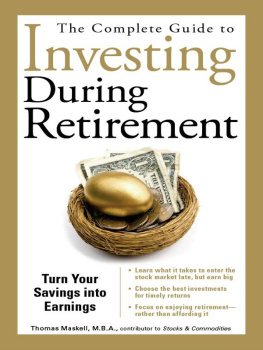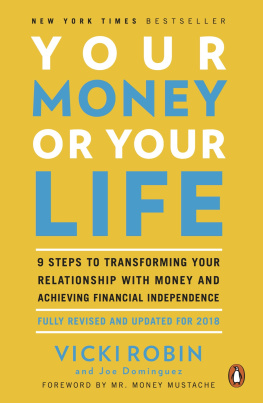Table of Contents
Multiply Your Money
The Easy Guide to Savings and Investments
Second edition
Nick Louth
For Louise, as always
About the author
Nick Louth has been an investment writer and a professional investor for nearly 30 years. He has been a regular contributor to the Financial Times , Investors Chronicle , Money Observer and numerous other publications. He is married and lives in Lincolnshire.
His website is at: www.nicklouth.com
Multiply Your Money was first published in 2001 by McGraw-Hill. This Harriman House edition is fully revised and updated.
Other investment titles
Funny Money
Bernard Jones and the Temple of Mammon
Dunces with Wolves
How to Double Your Money Every Ten Years (Without Really Trying)
Thrillers
Bite (an Amazon no. 1 bestseller)
Heartbreaker
Chapter 1.
Introduction
I n ancient Chinese legend a beggar was showing a new game he had invented to the children of a small village. They enjoyed the game, which was called chess, and very soon the adults were playing too. Eventually the emperor heard of it and summoned the beggar to his palace to explain the rules. This he did, and soon the emperor too had fallen in love with the game. One day, after they had finished playing, the emperor looked up and asked: What would you wish for, beggar man, as your reward for teaching me this marvellous game?
The beggar man thought hard, then cleared the pieces from the chess board. Just one grain of rice on the first square today, your Imperial Majesty.
Just one grain of rice?
Yes, your Imperial Majesty, just one grain of rice on the first square. And then tomorrow two grains of rice on the second square, four on the third square the day after, and so on for two months and four days until all sixty-four squares on the board are taken.
The emperor laughed, and readily agreed, for what kind of fool was this that needed only a few handfuls of rice for such a great service?
The beggar came back to the palace every day, and the children jeered at him as he showed them the few grains of rice in the palm of his hand. By the end of the first week he brought with him a teaspoon. A week later his rice filled a wooden bowl, and a week after that he struggled with a yoke across his shoulders, groaning rice baskets suspended at each end.
The children were now silent, as were the emperors advisors except for the frenetic clicking of their abacuses. Only when braying at the palace gates heralded the arrival of the first of the mule trains did the emperor realise he had been duped by the beggar into losing his empire. All the rice, from all the fields and granaries across all of China, would not be enough for the last square.
There is a magic in compound interest, and it can work for any of us. If each square on the chessboard is a year in your life, 10 a week invested on the first square can bring wealth of hundreds of thousands of pounds by the thirtieth or fortieth square, even with annual returns that we should expect to be around 7% rather than the 100% in the legend above.
The way to do this is to harness the engine of the economy, through the long-term ownership of shares. Many people have a couple of hundred shares from a building society demutualisation or from a privatisation, or have been left a shareholding in a will and are unsure what to do with it. Others may have never invested at all but have some savings they wish to put to work. This book will get you started, help you set your objectives and keep you away from the pitfalls that lurk for the unwary.
Of course, you dont have to own individual shares to multiply your money. There are investment funds which pool the money of thousands of people to give you the benefits of owning hundreds of different shares without having to keep track of them all. For most people, most of the time, this will be the simplest way to go. In the past such funds have tended to cream off a lot of the gains through high charges, but in recent years a breed of low-cost index trackers and exchange-traded funds (explained in chapter 10) puts almost the full power of the market right into your pocket.
For those whose investment horizon is retirement, self-invested personal pensions (SIPPs) allow you to harness the benefits of stock market growth with low charges and full tax relief. Pension types are covered in detail in chapter 4, and how to choose the right one for you is summarised briefly in chapter 5.
For many people the sheer idea of getting to grips with their finances is forbidding. Some are just starting out in their working life. Others are confronting reduced circumstances in middle age because of divorce. In chapters 68, Multiply Your Money outlines a few gradual and easy steps which anyone can make to keep track of their outgoings, turn the tables on debt, create savings and put them to work. Once you are confidently in charge of your money, never again need you dread filling out a tax return or opening a bank statement. Nor will you have to scrape together the money for a car or holiday.
Chapter 19 covers the property market and buy-to-let, another very useful way to harness the power of compound interest. For those who gather more experience, there are chapters describing how to limit risk, pick growth and value shares, and understand market cycles.
While this book does cover trading strategies, it is not intended for day-traders or those who are driven to become millionaires overnight. Common sense as well as plenty of academic research indicates that trying to second-guess the market by jumping in and out involves extra work and a lot of extra cost and is rarely worthwhile. While buying shares and never selling them is perhaps too passive in these days of rapid corporate change, it is certainly true that frenetic dealing undermines performance and peace of mind. Chapter 15 is concerned with selling gracefully, and that is what we aim to do.
I believe anyone can get very close to the markets historic average returns with less than 30 minutes work a week. If you take a view measured in years not minutes, you never need to lose sleep over the markets day-to-day gyrations either. Chapter 14 shows how the tides of markets move month by month, never quite repeating patterns but producing variations on them. While there is never a shortage of issues to worry about whether it is a financial crisis, inflation or interest rates the global economy, and the companies that are its engines, will continue to generate wealth. If you want to multiply your money, you need to harness that dynamism.
For those who are willing to own individual shares, the information age is a boon. The internet has opened up free sources of research that were previously only available to market professionals. There are a variety of accounts, such as individual savings accounts (ISAs) and SIPPs, which allow us to protect the bulk of our profits against tax. Commission charges on share-trading are coming down, it is becoming easier to invest abroad, and cheap execution-only brokers are eager for our custom. Chapter 11 shows you exactly how to get started: running a dummy portfolio, researching companies, finding a stockbroker, and making your first deals.
A full explanatory glossary is included at the back of the book.
By the time you finish Multiply Your Money you will have the tools and confidence to take charge of your finances, build savings and multiply your money. So start early, stay with it, and have fun.
Some bored mathematician has worked out that the number of rice grains on the last square would be eighteen trillion million, or 18,000,000,000,000,000,000, expressed more simply as 2.
Chapter 2.
The Incredible Savings Machine
Introduction
I f there is only one point you take out of this book, let it be this: if you want to stoke an investment engine that will eventually take you from modest means to being wealthy, you have to start early. The later you start, the more savings you need to put in to reach a given point.







